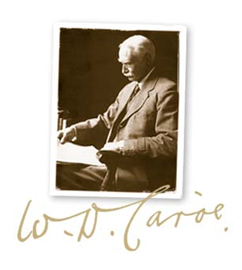 William Douglas Caröe, FSA, FRIBA (1857-1938). W.D.Caröe – who had been a pupil at Ruabon Grammar School as a contemporary of Frank Harris – founded the respected ecclesiastical architectural firm of Caröe & Partners in 1884.
William Douglas Caröe, FSA, FRIBA (1857-1938). W.D.Caröe – who had been a pupil at Ruabon Grammar School as a contemporary of Frank Harris – founded the respected ecclesiastical architectural firm of Caröe & Partners in 1884.
After leaving the school Caröe studied at Trinity College, Cambridge was articled to J L Pearson and became a major figure in the Arts and Crafts Movement. He was architect to the Ecclesiastical Commissioners from 1895 until his death and was architect to numerous ecclesiastical buildings including St David’s, Durham and Canterbury Cathedrals, Southwell Minster and Tewkesbury and Romsey Abbeys. He was President of the Architectural Association in 1895 and served on the Council of the Institute. Caröe was not only an architect of striking originality and a pioneer of building conservation, but also a distinguished designer of furniture, embroidery, metalwork and sculpture.
The rich legacy of the work of W.D. Caröe has never been of greater relevance. The revival of interest in architecture of the Edwardian period and of the 1920s and 1930s has provoked a re-evaluation of the work of those architects, like Caröe, who stood apart from the International Modern Movement to produce ‘traditional’ architecture.